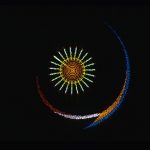John Whitney Sr.

ISEA Bio(s) Available:
[1917 – 1995]
Whitney was born in Pasadena, California and attended Pomona College. His first works in film were 8 mm movies of a lunar eclipse which he made using a home-made telescope. In 1937-38 he spent a year in Paris, studying twelve-tone composition under René Leibowitz. In 1939 he returned to America and began to collaborate with his brother James on a series of abstract films. In 1948 he was awarded a Guggenheim Fellowship.
During the 1950s, Whitney used his mechanical animation techniques to create sequences for television programs and commercials. In 1952, he directed engineering films on guided missileprojects. One of his most famous works from this period was the animated title sequence from Alfred Hitchcock’s 1958 film Vertigo, which he collaborated on with the graphic designer Saul Bass.
In 1960, he founded Motion Graphics Incorporated, which used the mechanical analog computer of his own invention to create motion picture and television title sequences and commercials. The following year, he assembled a record of the visual effects he had perfected using his device, titled simply Catalog. In 1966, IBM awarded John Whitney, Sr. its first artist-in-residence position.
By the 1970s, Whitney had abandoned his analog computer in favor of faster, digital processes. He taught the first computer graphics class at UCLA in 1972. The pinnacle of his digital films is his 1975 work Arabesque, characterized by psychedelic, blooming color-forms. In 1969-70, he experimented with motion graphics computer programming at California Institute of Technology. His work during the 1980s and 1990s benefited from faster computers and his invention of an audio-visual composition program called the Whitney-Reed RDTD (Radius-Differential Theta Differential). Works from this period, such as Moondrum (1989-1995), used self-composed music and often explored mystical or Native-American themes. (from wikipedia)
Last Known Location:
- United States






